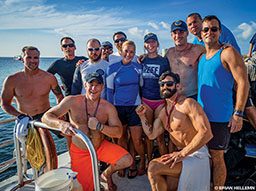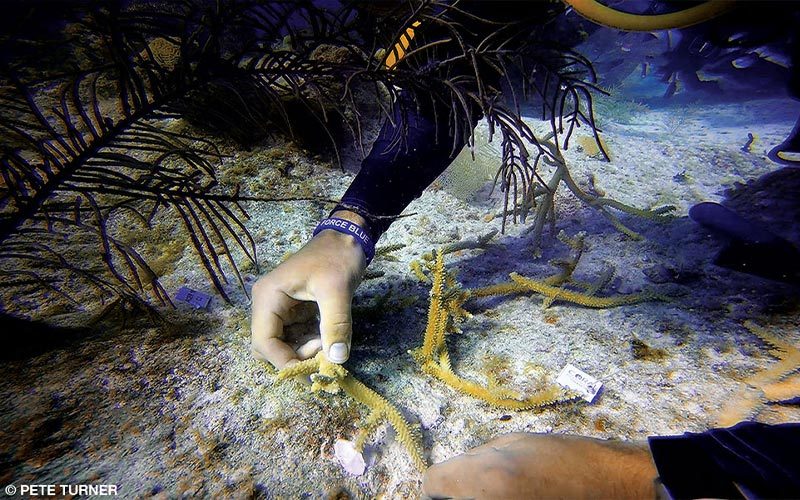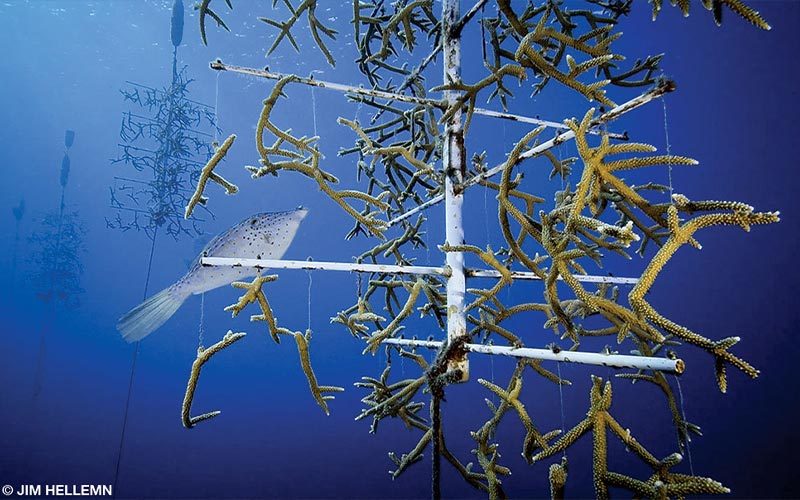Meet the ocean’s newest symbiotic relationship: threatened coral reefs and highly skilled military veterans. The nonprofit Force Blue is uniting former combat divers and special operations forces (SOF) veterans with the field of marine conservation for an important new mission: to experience and explore the planet’s coral reefs and to leverage their skills and teamwork to protect the ocean. Force Blue is giving veterans a new lease on life by teaching them how to restore fragile ocean habitats and helping them heal themselves in the process.
The idea behind Force Blue originated in June 2015 when Jim Ritterhoff and Rudy Reyes went on a dive trip to the Cayman Islands and connected with Keith Sahm, general manager of Grand Cayman’s Sunset House. This recreational dive trip was transformative for Reyes, a former reconnaissance Marine and combat diver. Reyes had struggled with post-traumatic stress disorder (PTSD) and depression since he returned from multiple tours in Iraq and Afghanistan, but he found diving for exploration and enjoyment to be therapeutic.

Ritterhoff, Reyes and Sahm founded Force Blue to give other former combat divers and SOF veterans the chance to observe critically endangered marine ecosystems and apply their specialized training to aid in protecting the ocean.
“We thought that if we could combine diving and marine conservation to give these highly trained combat veterans a positive new mission, we could help them while protecting the ocean as well,” Ritterhoff said.
For combat veterans, it can be difficult to adjust to an unstructured life after years of rigid regimen and military order, and some have trouble relating their well-honed military skills to civilian work. A study conducted by the U.S. Department of Veterans Affairs (VA) found that 25 percent to 56 percent of combat veterans reported “some” to “extreme” difficulty in social functioning, productivity, community involvement and self-care, and 96 percent of the 754 veterans who responded to the study expressed interest in services to help adjust to civilian life.1
Many people receive mental health support from the VA, but Force Blue’s goal is twofold: to give warriors a cause and to give a cause its warriors. Carrie Elk, Ph.D., founder of the Elk Institute for Psychological Health and Performance, provides PTSD treatment and training for Force Blue’s team. Her mission aligns with Force Blue’s cause: to restore the warriors and to restore the reefs.

Force Blue held its inaugural project, Mission One, at Sunset House in April 2017, bringing together six highly trained military veterans and a team of marine scientists and conservationists for a two-week training program. This deployment, as it was called, consisted of mission-focused, team-oriented projects to support ocean conservation, including coral reef restoration, invasive species removal and monitoring of critical species and habitats.
The veterans who participated in Mission One have struggled with the transition from war zones to everyday civilian life. One team member, Roger Sparks, was a former recon Marine and U.S. Air Force pararescueman who received the Silver Star for tending to nine wounded soldiers in Watapur Valley, Afghanistan. The team also included Reyes; Geoff Reeves, a Navy SEAL officer; former recon Marine Will Hinkson; U.S. Army Special Forces veteran Sean Moore; Jon Slayer, a British Royal Marine; and Nathan Quinn, an Army medic.
During their deployment in Grand Cayman, these veterans learned that their skills and training are transferable and can be harnessed in a positive way to support preservation of the ocean.
“We have aptitude and ability, and we have discipline and knowledge, but purpose is the keystone that holds it together,” Reyes said.
In a military-style training program, Mission One team members received instruction from ocean experts and lectures from some well-known people in marine conservation and diving, including conservationist Guy Harvey, underwater photographer Cathy Church and representatives from the Central Caribbean Marine Institute, the Coral Restoration Foundation, Oregon State University and the Reef Environmental Education Foundation.
The deployment also featured hands-on field projects each day. While in the Cayman Islands, Mission One team members dived the USS Kittiwake to examine the importance of artificial reefs, performed fish identification surveys and developed their underwater photography skills to document fish and coral population data. They also dived with sharks, snorkeled with stingrays, learned how to remove invasive lionfish, visited an endangered Nassau grouper aggregation site in Little Cayman, toured Grand Cayman’s coral nurseries and helped plant coral on damaged reefs.
On the final day of the deployment, the veterans placed a plaque 55 feet underwater at the base of Sunset House’s iconic mermaid statue to commemorate all military combat divers who have fought in defense of freedom. The Mission One team members attended a graduation ceremony that featured keynote speaker Wallace J. Nichols, Ph.D., a marine biologist and the author of New York Times bestselling book Blue Mind, which describes the remarkable effects that water and the ocean can have on our mental and physical well-being — a fitting topic for these divers who have struggled with PTSD.

“Force Blue brings together environmental and military interests to unite under a common cause for mutual benefit,” Ritterhoff said. Today approximately 3 million men and women are veterans of the wars in Iraq and Afghanistan. Mission-oriented combat veterans strongly identify with the cause, making them excellent ambassadors and advocates for the ocean.
“You don’t really comprehend sharks intellectually, but you realize they’re not as dangerous as they’re made out to be,” Hinkson said. “There’s such a distinct parallel between that and combat veterans.”
Moore shares that sentiment. “I can’t see the things that happened as a result of my actions in Iraq,” he said, “but I can see coral flourish.”
Ritterhoff hopes to see Force Blue become a network of SOF veterans who can form a rapid-response team to help after environmental incidents. He hopes to take the program to new destinations in the future, expanding Force Blue’s influence and assembling new teams to take on ocean conservation issues worldwide, helping to restore military veterans and the planet under one unified mission.
Reference
- Sayer NA, Noorbaloochi S, Frazier P, Carlson K, Gravely A, Murdoch M. Reintegration problems and treatment interests among Iraq and Afghanistan combat veterans receiving VA medical care. Psychiatr Serv. 2010 Jun; 61(6):589-97. doi: 10.1176/ps.2010.61.6.589
Explore More
| © Alert Diver — Q3 2017 |